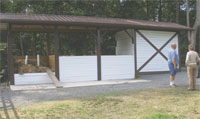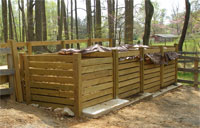Did you know that a single mature horse generates two cubic feet of waste per day? At that rate, waste management inevitably becomes a headache. Particularly at horse keeping operations on small acreages, an overwhelming manure mountain can quickly develop.
There are ways to manage your overflowing manure pile. These include paying to have waste picked up, giving away manure to neighbors or friends for gardening purposes, stacking and spreading waste over your pastures, or composting the waste and then selling or reusing the compost.
Of these methods, composting is the least expensive and most efficient approach for managing large quantities of manure. Composting is an aerobic process in which microorganisms (mainly bacteria, fungi and actinomycetes) convert organic materials, such as animal or yard waste, into a friable, highly organic soil-like substance called compost or humus.
The greatest advantage of composting over other manure management methods is the tremendous volume reduction of the waste. Thoroughly composted material can take up 50% or less of its original volume. Composting has many other great advantages, such as water pollution prevention, a significant reduction in offensive odors, and an end-product that is a lot easier to handle.
For horse-owners who typically manage manure by stacking and spreading it on their pastures, composting has additional benefits. During composting, temperatures can rise well above 140°F (60°C). If the temperature within the manure pile stays at 150°F (66°C) for three days, bacteria, pathogens, weed seeds, and other unwanted components in the pile will be killed. Compost also improves the quality of the soil by increasing microbial activity, increasing moisture retention capacity, and by adding readily available macro- and micro-nutrients that plants need to the soil. In contrast, simply stacking the waste can preserve some unfavorable manure components that can cause disease or weeds in your pasture; spreading uncomposted waste also does not readily improve soil tilth (the ability of the soil to be worked) or soil fertility. The nutrients contained in uncomposted animal waste are not readily available for plants to use—in fact, upon initial application, bacteria in waste actually use up a portion of the existing soil nutrients and can decrease the availability of nutrients in your pasture.
In order to get composting started in your manure pile, certain conditions must be in place. Your pile should have adequate amounts of moisture and oxygen, the ratio of carbon to nitrogen (C:N) within the material to be composted must be within the optimal range (between 25:1 and 30:1) and microorganisms must be present.
To help get the composting process started and keep it moving:
- make sure the pile is three to four feet high
- add grass clippings, urea or any high nitrogen-containing material if the pile doesn’t get hot enough, and
- maintain the moisture content of the pile.
The composting material should feel as moist as a damp sponge.
Dry bedding material, a common component of horse manure, typically contributes sufficient carbon to maintain a favorable C:N ratio in the stack. Once begun, the composting process will usually steer itself to completion, as long as the moisture level is maintained, and the pile is turned regularly for aeration and heat regulation.
 To prevent the manure pile from polluting ground or surface water resources, the composting manure should be stored on a less permeable or impervious base, such as compacted clay soil, a concrete slab or any other impervious layer. A roof or a tarp should be in place to protect the compost site from rain. To prevent surface runoff from flowing through the pile, locate the composting site at the highest elevation of the property or build a dirt berm on its uphill side.
To prevent the manure pile from polluting ground or surface water resources, the composting manure should be stored on a less permeable or impervious base, such as compacted clay soil, a concrete slab or any other impervious layer. A roof or a tarp should be in place to protect the compost site from rain. To prevent surface runoff from flowing through the pile, locate the composting site at the highest elevation of the property or build a dirt berm on its uphill side.
For operations with more than ten horses, a large, single unit composting shed is a practical facility for handling the large amount of waste produced by your animals. For smaller horse operations (10 horses or less), a multi-celled composting structure is generally adequate. Waste is stacked into the multi-celled composting structure one cell at a time, and rotated into the next cell as it composts.
 If yours is a small horse operation, you can build your own simple multi-celled composting structure in your backyard, for a relatively low cost. Alternatively, funding to build a composting facility is available through the Northern Virginia Soil and Water Conservation District. The district is the local administrator of the Virginia Agricultural Best Management Practice (BMP) Cost Share Program, a state program which can reimburse 75% of the approved cost of your composting facility. Additionally, you may be eligible for a state tax credit for any out-of-pocket expenses you incur after reimbursement. The district also can help you determine the proper size for your composting facility, as this varies depending on the number of horses that are kept in stalls, the percentage of day they spend in those stalls, and the length of your spreading cycles, among other factors.
If yours is a small horse operation, you can build your own simple multi-celled composting structure in your backyard, for a relatively low cost. Alternatively, funding to build a composting facility is available through the Northern Virginia Soil and Water Conservation District. The district is the local administrator of the Virginia Agricultural Best Management Practice (BMP) Cost Share Program, a state program which can reimburse 75% of the approved cost of your composting facility. Additionally, you may be eligible for a state tax credit for any out-of-pocket expenses you incur after reimbursement. The district also can help you determine the proper size for your composting facility, as this varies depending on the number of horses that are kept in stalls, the percentage of day they spend in those stalls, and the length of your spreading cycles, among other factors.
Please call NVSWCD at 703-324-1460, TTY 711 or send an e-mail for further information on sizing your composting facility, and for more information on participating in the Virginia Agricultural BMP Cost Share Program.
Make your own contribution toward reducing nutrient pollution within your watershed. Don’t let managing your horse waste be a headache anymore!

